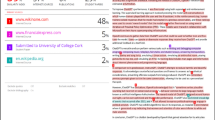No form of art goes beyond ordinary consciousness as film does, straight to our emotions, deep into the twilight room of the soul.
Ingrid Bergman
Abstract
This article recommends the film Inside Job as an effective teaching tool for illustrating the ethical issues that surrounded the global financial crisis of 2008 and the subsequent economic downturn. The study discusses issues such as the revolving door, conflicts of interest, fiduciary duty, executive compensation, and financial regulation. The presentation of each ethical issue comprises suggested questions, background information, and guides to specific sections of the film. An overview of the film is provided as well.
Similar content being viewed by others
Abbreviations
- CEO:
-
Chief executive officer
- CDO:
-
Collateralized debt obligation
- CFMA:
-
Commodity Futures Modernization Act
- CFTC:
-
Commodity Futures Trading Commission
- CDS:
-
Credit default swap
- OTC:
-
Over-the-counter
- SEC:
-
Securities and Exchange Commission
References
Berger, J., & Pratt, C. B. (1998). Teaching business-communication ethics with controversial films. Journal of Business Ethics, 17(6), 1817–1823.
Boddy, C. R. (2011). The corporate psychopaths theory of the global financial crisis. Journal of Business Ethics, 102(2), 255–259.
Cane, M. B., Shamir, A., & Jodar, T. (2011). Below investment grade and above the law: A past, present and future look at the accountability of credit rating agencies. Fordham Journal of Corporate and Financial Law, forthcoming. Retrieved from http://papers.ssrn.com/sol3/papers.cfm?abstract_id=1927907.
Champoux, J. E. (2006). At the cinema: Aspiring to a higher ethical standard. Academy of Management Learning & Education, 5(3), 386–390.
Chan, S. (2010, December 30). Academic economists to consider ethics code. The New York Times.
Chan, K. C., Weber, M., & Johnson, M. (1995). Using Other People’s Money in the classroom. Financial Practice and Education, 5(1), 123–129.
DeMartino, G. F. (2011). The economist’s oath: On the need for and content of professional economic ethics. New York: Oxford University Press.
Dolfsma, W. (2006). Accounting as applied ethics: Teaching a discipline. Journal of Business Ethics, 63(3), 209–215.
Dyl, E. A. (1991). Wall Street: A case in ethics. Financial Practice and Education, 1(1), 49–51.
Ferguson, C. H. (2010). Inside Job [Press kit]. New York: Sony Picture Classics. Retrieved from http://www.sonyclassics.com/insidejob/_pdf/insidejob_presskit.pdf.
Ferguson, C. H. (2012). Predator nation: Corporate criminals, political corruption, and the hijacking of America. New York: Crown Business.
Gandz, J., & Hayes, N. (1988). Teaching business ethics. Journal of Business Ethics, 7(9), 657–669.
Giacalone, R. A., & Jurkiewicz, C. L. (2001). Lights, camera, action: Teaching ethical decision making through the cinematic experience. Teaching Business Ethics, 5(1), 79–87.
Green, C. F. (1989). Business ethics in banking. Journal of Business Ethics, 8(8), 631–634.
Hall, K. G. (2012, May 8). Financial regulations unenforced, critics say. The Columbus Dispatch.
Harris, J. D. (2009). What’s wrong with executive compensation? Journal of Business Ethics, 85(1), 147–156.
Harrison, J. (2004). Film review: Screening classic dilemmas in the classroom. Journal of Business Ethics, 49(1), 105.
Klarman, S. A., & Zweig, J. (2010). Opportunities for patient investors. Financial Analysts Journal, 66(5), 18–28.
MacDonald, C., McDonald, M., & Norman, W. (2002). Charitable conflicts of interest. Journal of Business Ethics, 39(1–2), 67–74.
McDonald, G. M., & Donleavy, G. D. (1995). Objections to the teaching of business ethics. Journal of Business Ethics, 14(10), 839–853.
Moriarty, J. (2005). Do CEOs get paid too much? Business Ethics Quarterly, 15(2), 257–281.
Nichols, D., & Subramaniam, C. (2001). Executive compensation: Excessive or equitable? Journal of Business Ethics, 29(4), 339–351.
Nofsinger, J. R. (1995). Barbarians at the Gate: A capstone corporate finance project. Financial Practice and Education, 5(1), 118–122.
Ostapski, S. A., Oliver, J., & Gonzalez, G. T. (1996). The legal and ethical components of executive decision-making: A course for business managers. Journal of Business Ethics, 15(5), 571–579.
Palazzo, G., & Rethel, L. (2008). Conflicts of interest in financial intermediation. Journal of Business Ethics, 81(1), 193–207.
Partnoy, F. (2010). Inside Job—The official teacher’s guide. Retrieved from http://www.sonyclassics.com/insidejob/_pdf/InsideJob_StudyGuide.pdf.
Perel, M. (2003). An ethical perspective on CEO compensation. Journal of Business Ethics, 48(4), 381–391.
Poliak, S., & Roth, S. (2011, May 14). B-school faculty approve tougher conflict of interest rules. Columbia Spectator.
Rajan, R. G. (2005). Has financial development made the world riskier? Economic Symposium Conference Proceedings, Federal Reserve Bank of Kansas City, August, pp. 313–369.
Richards, L. A. (2006). Fiduciary duty: Return to first principles. Speech by the Director of the Office of Compliance Inspections and Examinations, U.S. Securities and Exchange Commission, Given at the Eighth Annual Investment Adviser Compliance Summit, Washington, D.C., February 27, 2006. Retrieved from http://www.sec.gov/news/speech/spch022706lar.htm.
Roper, J. E. (2004). Review of film: “A Civil Action”. Journal of Business Ethics, 49(3), 307–309.
Shaw, B. (2004). Hollywood ethics: Developing ethical issues… Hollywood style. Journal of Business Ethics, 49(2), 167–177.
Shiller, R. J. (2012). Finance and the good society. Princeton: Princeton University Press.
Sims, R. R., & Felton, E. L, Jr. (2006). Designing and delivering business ethics teaching and learning. Journal of Business Ethics, 63(3), 297–312.
Stout, L. A. (2011). Derivatives and the legal origin of the 2008 credit crisis. Harvard Business Law Review, 1, 1–38.
Van Es, R. (2003). Inside and outside The Insider: A film workshop in practical ethics. Journal of Business Ethics, 48(1), 89–97.
Wong, A., & Beckman, E. (1992). An applied ethical analysis system in business. Journal of Business Ethics, 11(3), 173–178.
Author information
Authors and Affiliations
Corresponding author
Appendix: Additional Materials
Appendix: Additional Materials
The website for Inside Job (http://www.sonyclassics.com/insidejob) is a significant source for background information and resources to facilitate the use of the film for classroom instruction. This material includes definitions of many of the terms used, brief introductions of individuals interviewed, and other related information. For example, the Jargon section of the website (http://www.sonyclassics.com/insidejob/site/#/thejargon) as well as the film’s press kit (Ferguson 2010) define terms such as CDOs and mortgage-backed securities. In addition, the Official Teachers’ Guide (Partnoy 2010) is freely available on the film’s website and provides additional details regarding the formation of mortgage-backed securities.
The Cast section of the website (http://www.sonyclassics.com/insidejob/site/#/cast) presents short introductions of the individuals interviewed in the film. These individuals are divided into seven groups and include academics and journalists as well as “those who warned us” and “those who might regret their comments.” Individuals who declined to be interviewed for the film are also listed.
The website provides a list of news articles and Internet resources that document past criminal activities with which various firms in the financial services industry have been charged and regulatory infractions for which they have paid substantial fees. A timeline beginning from the Glass–Steagall and the Securities and Exchange Acts of the 1930s highlights the major events in the financial industry through the crisis.
In addition to the film’s website, the Ferguson’s (2012) book Predator Nation: Corporate Criminals, Political Corruption, and the Hijacking of America provides additional background information on many issues highlighted in the film and discussed in this article, such as deregulation, rating agencies, and conflicts of interest in academia. Published 2 years after the film’s release, the book picks up where the film left off with the opening chapter titled as the last part of the film: “Where We Are Now.” The concluding chapter of the book addresses the question “What Should Be Done?”
Rights and permissions
About this article
Cite this article
Biktimirov, E.N., Cyr, D. Using Inside Job to Teach Business Ethics. J Bus Ethics 117, 209–219 (2013). https://doi.org/10.1007/s10551-012-1516-y
Received:
Accepted:
Published:
Issue Date:
DOI: https://doi.org/10.1007/s10551-012-1516-y




